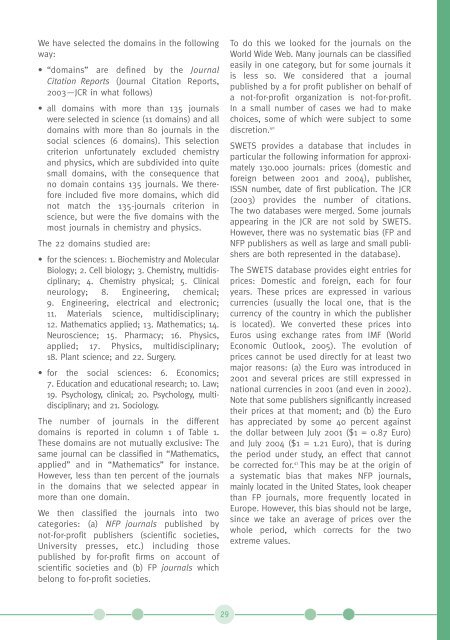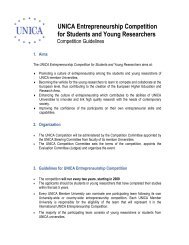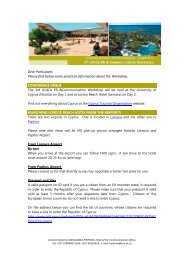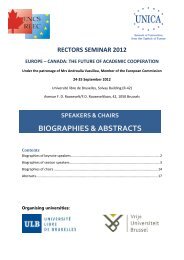Study on the economic and technical evolution of the scientific ...
Study on the economic and technical evolution of the scientific ...
Study on the economic and technical evolution of the scientific ...
You also want an ePaper? Increase the reach of your titles
YUMPU automatically turns print PDFs into web optimized ePapers that Google loves.
We have selected <strong>the</strong> domains in <strong>the</strong> following<br />
way:<br />
• “domains” are defined by <strong>the</strong> Journal<br />
Citati<strong>on</strong> Reports (Journal Citati<strong>on</strong> Reports,<br />
2003—JCR in what follows)<br />
• all domains with more than 135 journals<br />
were selected in science (11 domains) <strong>and</strong> all<br />
domains with more than 80 journals in <strong>the</strong><br />
social sciences (6 domains). This selecti<strong>on</strong><br />
criteri<strong>on</strong> unfortunately excluded chemistry<br />
<strong>and</strong> physics, which are subdivided into quite<br />
small domains, with <strong>the</strong> c<strong>on</strong>sequence that<br />
no domain c<strong>on</strong>tains 135 journals. We <strong>the</strong>refore<br />
included five more domains, which did<br />
not match <strong>the</strong> 135-journals criteri<strong>on</strong> in<br />
science, but were <strong>the</strong> five domains with <strong>the</strong><br />
most journals in chemistry <strong>and</strong> physics.<br />
The 22 domains studied are:<br />
• for <strong>the</strong> sciences: 1. Biochemistry <strong>and</strong> Molecular<br />
Biology; 2. Cell biology; 3. Chemistry, multidisciplinary;<br />
4. Chemistry physical; 5. Clinical<br />
neurology; 8. Engineering, chemical;<br />
9. Engineering, electrical <strong>and</strong> electr<strong>on</strong>ic;<br />
11. Materials science, multidisciplinary;<br />
12. Ma<strong>the</strong>matics applied; 13. Ma<strong>the</strong>matics; 14.<br />
Neuroscience; 15. Pharmacy; 16. Physics,<br />
applied; 17. Physics, multidisciplinary;<br />
18. Plant science; <strong>and</strong> 22. Surgery.<br />
• for <strong>the</strong> social sciences: 6. Ec<strong>on</strong>omics;<br />
7. Educati<strong>on</strong> <strong>and</strong> educati<strong>on</strong>al research; 10. Law;<br />
19. Psychology, clinical; 20. Psychology, multidisciplinary;<br />
<strong>and</strong> 21. Sociology.<br />
The number <strong>of</strong> journals in <strong>the</strong> different<br />
domains is reported in column 1 <strong>of</strong> Table 1.<br />
These domains are not mutually exclusive: The<br />
same journal can be classified in “Ma<strong>the</strong>matics,<br />
applied” <strong>and</strong> in “Ma<strong>the</strong>matics” for instance.<br />
However, less than ten percent <strong>of</strong> <strong>the</strong> journals<br />
in <strong>the</strong> domains that we selected appear in<br />
more than <strong>on</strong>e domain.<br />
We <strong>the</strong>n classified <strong>the</strong> journals into two<br />
categories: (a) NFP journals published by<br />
not-for-pr<strong>of</strong>it publishers (<strong>scientific</strong> societies,<br />
University presses, etc.) including those<br />
published by for-pr<strong>of</strong>it firms <strong>on</strong> account <strong>of</strong><br />
<strong>scientific</strong> societies <strong>and</strong> (b) FP journals which<br />
bel<strong>on</strong>g to for-pr<strong>of</strong>it societies.<br />
To do this we looked for <strong>the</strong> journals <strong>on</strong> <strong>the</strong><br />
World Wide Web. Many journals can be classified<br />
easily in <strong>on</strong>e category, but for some journals it<br />
is less so. We c<strong>on</strong>sidered that a journal<br />
published by a for pr<strong>of</strong>it publisher <strong>on</strong> behalf <strong>of</strong><br />
a not-for-pr<strong>of</strong>it organizati<strong>on</strong> is not-for-pr<strong>of</strong>it.<br />
In a small number <strong>of</strong> cases we had to make<br />
choices, some <strong>of</strong> which were subject to some<br />
discreti<strong>on</strong>. 40<br />
SWETS provides a database that includes in<br />
particular <strong>the</strong> following informati<strong>on</strong> for approximately<br />
130.000 journals: prices (domestic <strong>and</strong><br />
foreign between 2001 <strong>and</strong> 2004), publisher,<br />
ISSN number, date <strong>of</strong> first publicati<strong>on</strong>. The JCR<br />
(2003) provides <strong>the</strong> number <strong>of</strong> citati<strong>on</strong>s.<br />
The two databases were merged. Some journals<br />
appearing in <strong>the</strong> JCR are not sold by SWETS.<br />
However, <strong>the</strong>re was no systematic bias (FP <strong>and</strong><br />
NFP publishers as well as large <strong>and</strong> small publishers<br />
are both represented in <strong>the</strong> database).<br />
The SWETS database provides eight entries for<br />
prices: Domestic <strong>and</strong> foreign, each for four<br />
years. These prices are expressed in various<br />
currencies (usually <strong>the</strong> local <strong>on</strong>e, that is <strong>the</strong><br />
currency <strong>of</strong> <strong>the</strong> country in which <strong>the</strong> publisher<br />
is located). We c<strong>on</strong>verted <strong>the</strong>se prices into<br />
Euros using exchange rates from IMF (World<br />
Ec<strong>on</strong>omic Outlook, 2005). The evoluti<strong>on</strong> <strong>of</strong><br />
prices cannot be used directly for at least two<br />
major reas<strong>on</strong>s: (a) <strong>the</strong> Euro was introduced in<br />
2001 <strong>and</strong> several prices are still expressed in<br />
nati<strong>on</strong>al currencies in 2001 (<strong>and</strong> even in 2002).<br />
Note that some publishers significantly increased<br />
<strong>the</strong>ir prices at that moment; <strong>and</strong> (b) <strong>the</strong> Euro<br />
has appreciated by some 40 percent against<br />
<strong>the</strong> dollar between July 2001 ($1 = 0.87 Euro)<br />
<strong>and</strong> July 2004 ($1 = 1.21 Euro), that is during<br />
<strong>the</strong> period under study, an effect that cannot<br />
be corrected for. 41 This may be at <strong>the</strong> origin <strong>of</strong><br />
a systematic bias that makes NFP journals,<br />
mainly located in <strong>the</strong> United States, look cheaper<br />
than FP journals, more frequently located in<br />
Europe. However, this bias should not be large,<br />
since we take an average <strong>of</strong> prices over <strong>the</strong><br />
whole period, which corrects for <strong>the</strong> two<br />
extreme values.<br />
29
















